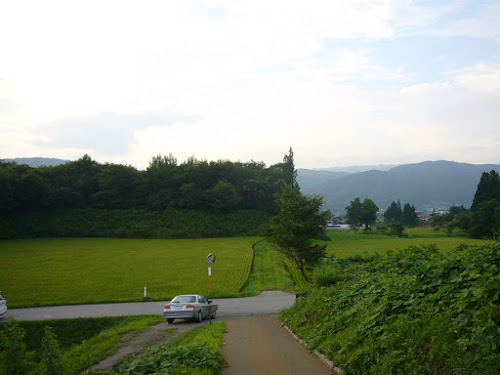They processed wheat which were
cropped last month. They also held an important annual event “Bon” to
welcome their ancestral spirits. Ordinary days continued.
この月は、麦片臼という語が6回、麦真臼という語が8回出てくる。麦を粉にしているのだろう。そして、お盆だ。平々凡々な日々が続く。
On the 1st, they continued
weeding.
On the 2nd, they still
continued weeding. They also cleaned wheat.
On the 3rd, it was the
last day of hard-work weeding, so they took rest in the afternoon.
On the 4th, Shigesaburou,
who departed to Mt. Fuji on the 23rd of June, brought his souvenirs to Mr.
Yoshino. It was also written “Fuji-tour leave in the afternoon”, so people
celebrated his safety trip and heard his story. On the
other hand, they started to mill the wheat. They did it from the 7th
to 11th, and after the Bon they resumed it until the 24th.
 |
The outfits
to go to the holly mountain early 20th century、木曽御嶽山詣、Nerima Shakujiikoen Furusato Museum 石神井公園ふるさと文化館
|
1日からは田草取りが三日続くが、それにて田草取りは終了。2日は、麦搗きが行われている。3日は、最後の田草取りがあって、昼から土用休日。4日、6月23日に出立した重三郎の富士参詣の土産を貰う。そして、「昼より富士参帰り休日」と記載されている。皆で、帰宅を祝い、土産話を聞いたのだろう。また、麦片臼はじめとあり、小麦粉を作る仕事が始まる。麦片臼は、7日~10日まで行い、11日は麦真臼。お盆を挟んで、18日から再開され24日まで続く。
On the 8th, they took leave in the
afternoon. They didn’t need to farm everyday in this month. Rice were growing
by themselves.
On the 9th, a person from Mt.
Haruna, which is a holly mountain, came.On the 10th, he visited Mr. Handa to pray for the first Bon rite of someone. He offered candles and white rice.
On the 11th, they dried clothes under sunny weather. Meanwhile a young helper Nijyurou returned to his home village. He spent Bon season there and returned to Yoshino’s house on the 29th. He preferred his home.
 |
Ornament of the Bon @ Kanagawa Prefectural Museum of Cultural History
(part2)、神奈川県立歴史博物館(2)
|
On the 13th, they set fire to welcome their ancestor’s spirits as usual.
On the 14th, his extended family went to Nakadera temple at dawn and greeted one another.
His father went to the tomb in Kashiwa on the 15th, and went to Nakadera temple for Segaki rite on the 16th. It was hold for both of lonely spirits and unfortune spirits.
On the 17th, his mother went to Segaki rite at Honngakuji temple. She also went to Segaki at Toueiji temple on the 22nd.
8日、昼よりしめり休日、とある。7日は昼まで雨、この日は晴れで南風なので、「しめり」の意味が分からない。
9日、榛名山登坊代、という人が来る。榛名山からの来訪者は珍しい。10日、半田利右衛門、新盆に白米袋入り蝋燭を持っていく、とあり新盆に訪れている。
11日、晴れの日で、衣類土用干し。仁十郎は、夕刻、中野久木に行ってしまう。
13日、夕方、お盆の迎え火となる。
14日、ルーチンの行事だ。「例の通り、暁墓参。中寺へ禮に行き芝三家村方相禮」とある。
15日は、父が柏へ墓参。
16日は、父が中寺へ施餓鬼に行くと書かれている。
17日は、母が、西平井本覚寺に施餓鬼に行く。施餓鬼は、もともとは無縁の亡者の礼や鬼衆に飲食を施す法会だ。 母は、22日にも東栄寺に施餓鬼に行っている。
On the 18th, they resumed farming.
On the 19th, his father went to the
meeting of the road construction which continued long time. He and his father shared
their job.
They cut trees and branches from the 20th
to the 22nd. They worked hard even in the hot summer.
On the 24th, they hold Segaki at
their community center, so it was held a lot. I guess it was also a joyful summer
event in which they ate, drunk and talk together. They took “Segaki leave” in
the afternoon of the next day. It is no doubt it was a kind of entertainments. On the 24th and 25th, his father joined the road construction meeting.
On the 27th and 28th, Gisaburou and Kanzaemon went out to mill wheat; perhaps they helped other family. In the rice planting season, they also helped one another, so the mutual aid system was established probably.
 |
| The road of the farming area, To-ono、遠野にて |
18日から、麦真臼ということで、農作業が再開する。
19日、道普請の話が始まっているが、父が打ち合わせに出かけている。主人と役割分担ができているのだろう。20日、屋敷山刈り、とあり、暑い中、山仕事もする。三日間続き、良く働く。
24日、寮にて施餓鬼修業、とあり、芝崎の地元行事だったのだろう。こんなにあるということは、施餓鬼にかこつけて食べたり飲んだり楽しいのか、或いは、集まって話すことが良いのか。お盆に続く、夏のイベントだ。25日は、昼より施餓鬼休日とあるから、24日はよっぽど盛り上がったのだろう。
25日、26日、道普請の話題が続く。
27日、28日、義三郎、勘左衛門、麦臼に行く、とあり、他家を助けに行ったのか。田植の時もあったが、互助関係ができていたという。
29日、仁三郎君が戻る。
Previous
post: Yoshino’s daily life 19, June in 1851(嘉永4年6月)
Next
post: Yoshino’s daily life 21, August in 1851(嘉永4年8月) Yoshino’s daily life 02, Life and fun of Yoshino family 吉野家の暮らしと楽しみ
Comments
Post a Comment